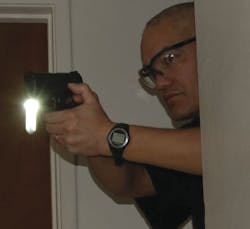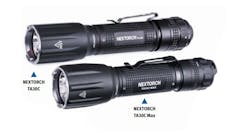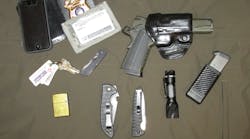I recently tested the Streamlight TLR-3 rail-mounted tactical LED light. In the tactical world, simpler is better. The TLR-3 proved itself an excellent addition to the tactical inventory.
The Streamlight TLR-3 is a 90-lumen, C4 LED illumination weapon mount light made mostly of polymer. It is impact resistant, dust and shockproof, with a waterproof rating of IPX7 — more than adequate for any aspect of law enforcement or military applications. It has a run time of 1.5 hours and weighs 2.3 ounces. It is powered by a single CR2 lithium battery, which contributes to its reduced size and weight; it is only 2 3/4 inches long and 1 1/2 inches tall. When mounted on a full-size duty handgun, it sits nearly flush with the end of the barrel and barely clears the trigger guard on the bottom.
When handgun-mounted lights first became popular, they had their place in a limited capacity. Handgun-mounted lights work for assignments where the user generally has a primary mission that precludes the use of both hands. The most likely deployment is for canine handlers and entry team members bearing ballistic shields or rappelling. Although I prefer a hand torch, I have used a rail-mounted light to search attics and crawlspaces, and they definitely have some utility there.
I mounted my light on my FNP-9 from FNH-USA. This is a lightweight, high capacity handgun suitable for concealed carry or duty use. The first trip to the range included lighting the target while firing Remington Golden Saber HPJ Bonded 147 grain bullets.
The best feature about the TLR-3 is the way it mounts. Lesser products require the user to hold the light in one hand and mate it with the gun by sliding it on from the muzzle. Somewhere in this equation the hand holding the light can potentially cross in front of the muzzle. On the TLR-3, the spring-loaded rail clamp lets users mount it from the side and tighten it using one hand.
Our testers were able to mount the light quickly, with little practice. One can preload the screw, which cinches it to the rail enough to be ready for action if the gun needs to come into play before it was tightened. The latch mechanism is spring loaded, and its two steel pins add to the rigidity of the mount. I shot for an entire afternoon without tightening the screw. As weapons lights go, this is one of the best for getting it into play under stress.
The product comes complete with a key kit, which consisted of various inserts for the rail mounting area. One selects the appropriate key, which fills any void in the mounting area. I didn't need one for my FNP-9, but there was an appropriate key for the rail on my shotgun. Incidentally, the TLR-3 is excellent for that shotgun or carbine with multiple accessories because of its low profile. It is also the most likely fit for the subcompact model of a duty gun, as it sticks out less than larger lights.
The Streamlight TLR-3 uses a toggle switch with paddle ends that straddle the trigger guard. It is a momentary switch when the seesaw-like paddle is rotated counterclockwise, and a "constant on" switch when rotated clockwise. I found I could easily operate the light left-handed or right-handed. The switch didn't get in the way of the operation of the gun, nor was it hard to work the switch between shots.
Impressively, the light didn't flicker on under recoil and stayed on when I needed it to stay on — provided I did not rest a finger on the switch, which is a bad technique anyway. I let shooters with a variety of hand sizes try the TLR-3/FNP-9 combination. The TLR-3 also worked with smaller hands, which is often an issue with this type of product. That is, the switch protruded enough for short fingers to work the controls.
I liked the molded flat surface on the bottom and its narrow profile. It didn't interfere with the characteristics of my gun, nor did it impede my ability to shoot barricaded. I mounted it to my Glock 22 and it was a smooth draw from my Bianchi Vision 90 holster. The simple construction and O-ring seal kept the TLR-3 water tight, and the impact-resistant polymer did just fine under shock tests.
Streamlight uses a Borofloat high temperature glass lens, a temperature and chemical-resistant product often used for engineering applications. It has all of the excellent properties of glass, including its ability to remain transparent in adverse conditions, yet adds shock resistance. This is an excellent choice for a product that will be exposed to hot gases, warm LEDs and abrasive deposits.
The reflector is a fairly deep parabola with a textured surface. It throws a concentrated center beam with diffused edges. At about 5 yards distance, the beam is only a yard wide. It delivers reduced peripheral light for a building search, but it is tight enough to encourage target focus.
I was able to test the mounted light on a foggy evening and it produced less backscatter than several of my patrol lights. It punched through low visibility well and allowed for better target identification down alleyways than a similar 120 lumen light. This is an important feature, as the user of this product will likely want to know how it does after dousing a home interior with smoke.
The front side of the TLR-3 is machined aluminum. It seemed to regulate the heat buildup well, and the regulated circuit kept the beam consistent throughout the life of the power cell.
Streamlight made this product a little smaller and lighter by using the CR2 cell instead of the usual CR123 cell. At first I was a little concerned, as this is usually a more expensive cell. However, a quick look at some suppliers suggested that the prices have some parity now. Bear in mind CR2 cells generally are a few hundred milliamp hours short of the CR123. But my TLR-3 didn't know the difference, and the 1.5 hours of regulated run time is more than reasonable.
The Streamlight TLR-3 is an excellent selection for the tactical user. It is small enough to fit in a pocket and bright enough to fit in an entry team's kit. Streamlight has proven that simpler is better.
Lindsey Bertomen is a retired police officer who teaches at Hartnell College in Salinas, Calif.



